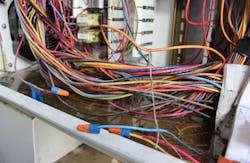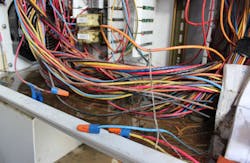By Pat Beisert
If a natural disaster occurs, who at your company know what steps to take? With the emergency passed, what’s the plan to get back to full production?
Electrical infrastructure, in particular, is susceptible to damage from hurricane, tornado, flood or over-flow. Let’s review some ways to be best prepared to protect and recover the electrical infrastructure of a process industry plant following a disaster.
Disaster can strike without much notice and allow very little time to protect the most important equipment needed to get the business back on its feet. Yet preparation involves three simple steps: planning for recovery, proper documentation of the plant resources and disaster-recovery support.
A facility’s electrical-engineering team typically has responsibility for electrical infrastructure and should be the primary driver behind preparing for disaster recovery. The electrical staff enlists a disaster-response planning committee with a designated chairperson.
The committee is assisted by individual department managers in developing a disaster-preparedness plan for their equipment and processes, which can be combined to cover the entire facility. Critical items considered by the committee include identifying the safety systems needed before entering a plant following a disaster — including fire pumps, lighting, emergency communications and many others.
System anatomy
The electrical system is broken down into separate parts for recovery planning purposes:
- The system’s medium-voltage backbone
- Transformers
- 480-volt distribution
- Motors and pumps
- Drives and automation
A short list of the documentation that should be up to date and readily available includes plant one-line and three-line drawings; automation programs available for download into recovered or replaced equipment; relay and electrical drive setting file, process-control diagrams, equipment-maintenance records and others.
Too often the need for this information is thought of after the disaster. Its lack complicates and prolongs recovery because data, drawings, diagrams and processes will need redevelopment before production can restart. A little bit of planning goes a long way during the recovery stages.
After a disaster, it is critical that any potential sources of electrical energy have been identified, including any potential for back feeds. Accurate one-line drawings should be updated routinely as equipment is added or removed from the electrical system.
Identify essential assets first, especially the equipment important to personnel safety. These usually include fire control, evacuation and alerting equipment. There should also be plans for rapid restoration of water & wastewater, facility lighting, critical valve-actuators and air & water monitoring systems.
Blue prints and master data
Keep an accurate blueprint of all utility lines and pipes associated with the facility and grounds.
Develop switching procedures and a lock-out / tag-out plan for an emergency shutdown of power and other utilities.
Capacitors, UPS systems and long cable runs can maintain a stored charge. Grounding may or may not be practical on each and every point of the service entrance, but it should be performed wherever and whenever possible.
Maintain a list of phone numbers, including night and day emergency reporting and repair services, of all serving utility companies.
Inventory all equipment through an asset-management database, equipment-trending tools available on line or even a basic spread sheet.
It is highly recommended to have at least one complete and accurate schematic, stored electronically, secured but accessible to those who may need it. For some facilities, this is a big undertaking, but one that will pay off immensely in the event of a disaster. Distribution to key vendors, suppliers and recovery personnel prior to a disaster event is a must and should be included as a supplier-performance item and monitored through facility readiness exercises.
Documentation should also include equipment condition-monitoring data and performance history, which can guide reality-based asset recovery or replacement. Age is not the only consideration for electrical equipment replacement. It might be advantageous to include component upgrades or other life-extension steps. If there is concern regarding long-term reliability, remanufactured products can allow service restoration until replacements are found.
Disaster recovery support
It may be desirable to develop special disaster-recovery contracts with vendors for the specific roles they will play in the recovery project. These agreements are specifically "set aside for disasters only" and may be with equipment manufacturers, security firms, equipment rental companies, electrical equipment remanufacturing companies and the key disaster-recovery company.
You’ll need to qualify your worst-case scenario, as well as specify and qualify personnel and equipment in the facility. This is especially so regarding safety training, immunization or other specialized needs. Disaster-recovery hourly rates and other costs associated with an emergency are much different than standard service rates for a normal working day, due to costs associated with rapid mobilization and limited access to lodging, meals and fuel.
Consider that many existing blanket agreements may not be considered "valid" by suppliers during disasters, when materials and equipment need expediting. Qualify existing lines of credit with your suppliers, as disasters commonly exceed these limitations. Extended payment terms are often needed when insurance companies are involved.
An army marches on its stomach and so do electrical restoration workers. Keeping personnel on site and effective is critical. Organized, fresh, hot food for lunch and dinner when working long days is a must for both efficiency and worker morale. Locating these resources in a disaster struck area is a challenge on its own. Topographical maps can assist when calculating flood zones and affected areas. Locating suppliers in areas less likely to be flooded will be critical to feeding the forces.
Disaster preparedness should also include pre-event contracting with multiple suppliers for rental power equipment, power cables, distribution switches, circuit breakers and power-distribution panels. Consider the possible need for heating and cooling units that include cooling towers, chillers and air handlers. There must be adequate facility space for temporary or longer-term storage, installation and operation.
Concluding considerations
When contracting for rental equipment, multiple suppliers are best, to ensure availability or equipment shopping based on delivery. It might be wise to check on emissions associated with the equipment, as a massive recovery effort might raise environmental issues. Make sure you’ll have the spare parts needed.
Bad planning can result in inadequate power and inoperable equipment. Periodically evaluate the back-up power plan. Facilities expand and operations change over time. When installing temporary equipment into an existing electrical scheme, risk of accidental shock, electrocution, and burn are dramatically increased without written procedures for connecting, controlling and energizing equipment. Electrical one-line drawings and other site maps should be updated to include where emergency generators and other equipment are added or removed from the electrical system. A system of agency and code permitting and proper fuel management should be instituted as well.
Disasters are nothing new, but there is some evidence that climate change is leading to greater variability in weather patterns. The impact of weather events can destroy infrastructure and change our lives. So why not be ready to handle what may be headed our way? Proper planning and timely implementation will ensure the safest and speediest return to normalcy for the company, its employees and their families.
Pat Beisert is the vice president of production with Irving, Texas-based Shermco Industries.
Shermco Industries is a provider of testing, maintenance, repair, commissioning, engineering and training services for electrical infrastructure, including substations, switch gear, transformers, motors and generators.



